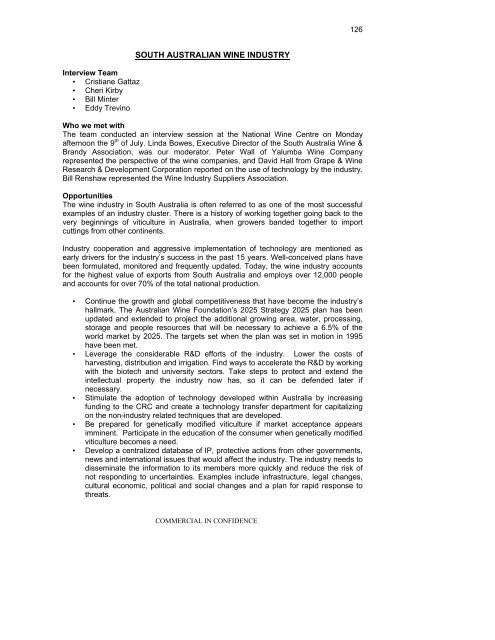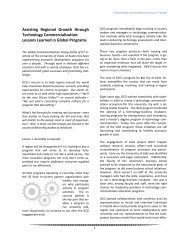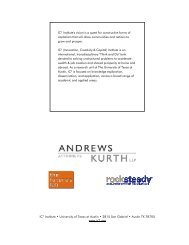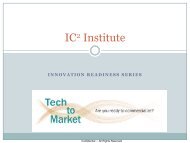“Quicklook” Assessment of Greater Adelaide's Assets & Challenges ...
“Quicklook” Assessment of Greater Adelaide's Assets & Challenges ...
“Quicklook” Assessment of Greater Adelaide's Assets & Challenges ...
You also want an ePaper? Increase the reach of your titles
YUMPU automatically turns print PDFs into web optimized ePapers that Google loves.
Interview Team<br />
• Cristiane Gattaz<br />
• Cheri Kirby<br />
• Bill Minter<br />
• Eddy Trevino<br />
SOUTH AUSTRALIAN WINE INDUSTRY<br />
Who we met with<br />
The team conducted an interview session at the National Wine Centre on Monday<br />
afternoon the 9 th <strong>of</strong> July. Linda Bowes, Executive Director <strong>of</strong> the South Australia Wine &<br />
Brandy Association, was our moderator. Peter Wall <strong>of</strong> Yalumba Wine Company<br />
represented the perspective <strong>of</strong> the wine companies, and David Hall from Grape & Wine<br />
Research & Development Corporation reported on the use <strong>of</strong> technology by the industry.<br />
Bill Renshaw represented the Wine Industry Suppliers Association.<br />
Opportunities<br />
The wine industry in South Australia is <strong>of</strong>ten referred to as one <strong>of</strong> the most successful<br />
examples <strong>of</strong> an industry cluster. There is a history <strong>of</strong> working together going back to the<br />
very beginnings <strong>of</strong> viticulture in Australia, when growers banded together to import<br />
cuttings from other continents.<br />
Industry cooperation and aggressive implementation <strong>of</strong> technology are mentioned as<br />
early drivers for the industry’s success in the past 15 years. Well-conceived plans have<br />
been formulated, monitored and frequently updated. Today, the wine industry accounts<br />
for the highest value <strong>of</strong> exports from South Australia and employs over 12,000 people<br />
and accounts for over 70% <strong>of</strong> the total national production.<br />
• Continue the growth and global competitiveness that have become the industry’s<br />
hallmark. The Australian Wine Foundation’s 2025 Strategy 2025 plan has been<br />
updated and extended to project the additional growing area, water, processing,<br />
storage and people resources that will be necessary to achieve a 6.5% <strong>of</strong> the<br />
world market by 2025. The targets set when the plan was set in motion in 1995<br />
have been met.<br />
• Leverage the considerable R&D efforts <strong>of</strong> the industry. Lower the costs <strong>of</strong><br />
harvesting, distribution and irrigation. Find ways to accelerate the R&D by working<br />
with the biotech and university sectors. Take steps to protect and extend the<br />
intellectual property the industry now has, so it can be defended later if<br />
necessary.<br />
• Stimulate the adoption <strong>of</strong> technology developed within Australia by increasing<br />
funding to the CRC and create a technology transfer department for capitalizing<br />
on the non-industry related techniques that are developed.<br />
• Be prepared for genetically modified viticulture if market acceptance appears<br />
imminent. Participate in the education <strong>of</strong> the consumer when genetically modified<br />
viticulture becomes a need.<br />
• Develop a centralized database <strong>of</strong> IP, protective actions from other governments,<br />
news and international issues that would affect the industry. The industry needs to<br />
disseminate the information to its members more quickly and reduce the risk <strong>of</strong><br />
not responding to uncertainties. Examples include infrastructure, legal changes,<br />
cultural economic, political and social changes and a plan for rapid response to<br />
threats.<br />
COMMERCIAL IN CONFIDENCE<br />
126





